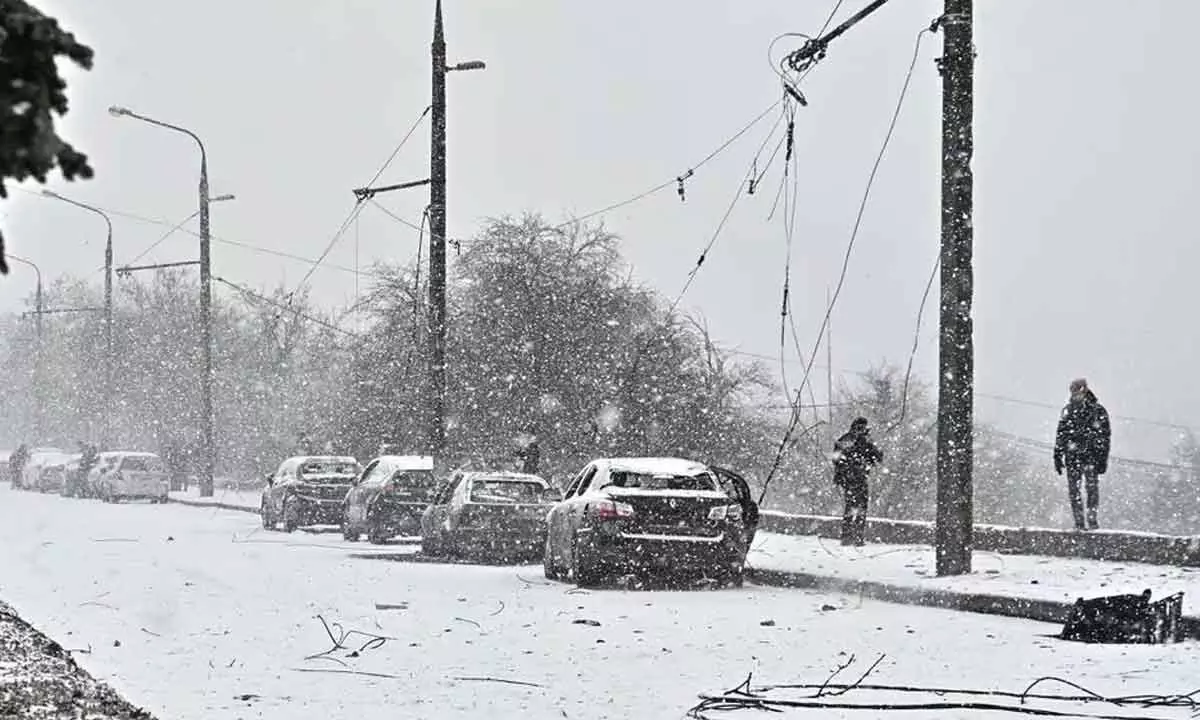Help Ukraine survive the winter

The international community should amplify Ukrainian voices and recognise the urgency of their situation as the second anniversary of the Russian invasion approaches. One only has to look back to last year’s harsh winter to understand what residents face. Ukraine confronted significant challenges as local communities grappled with severe cold temperatures. Russian forces then exacerbated this humanitarian crisis by targeting essential civilian infrastructure that kept people safe and warm in the frigid cold
As the spotlight on Ukraine dwindles, individuals and families are still fighting to survive the perpetual terror they’re experiencing. The two-year mark of the Ukraine war is coming up at the end of the month, just as the coldest period of winter blankets the region.
Citizens are facing renewed Russian attacks and the daunting challenge of securing suitable shelter to endure the frigid weather. As the Country Director and the Regional Director of CORE’s (Community Organized Relief Effort) Ukraine response team, we are working tirelessly to rebuild and assist communities throughout the country this winter.
One only has to look back to last year’s harsh winter to understand what residents face. Ukraine confronted significant challenges as local communities grappled with severe cold temperatures. Thousands of families were living in makeshift shelters after devastating attacks displaced them from their homes. Russian forces then exacerbated this humanitarian crisis by targeting essential civilian infrastructure that kept people safe and warm in the frigid cold.
The people of Ukraine face the dire challenge of enduring the ongoing conflict while braving freezing temperatures and heavy snowfall.
In response to these pressing needs, CORE has delivered support to “Invincibility Centers” established by the government in eight regions of Ukraine, which covered more than 100,000 affected people and are continuing to do so this year. These centers were designed to equip communities for winter by supplying crucial resources like food, water, firewood, and other necessities. Public buildings, such as schools, have been transformed into habitable shelters, offering much-needed relief to the affected Ukrainians, and will continue to get upgraded this winter.
In addition to supporting the upgrading of Invincibility Centers, CORE is zeroing in on critical aspects of community resilience, focusing on Water, Sanitation, and Hygiene (WASH) systems, upgrading bomb shelters for schools, refurbishing collective centers, and supplying construction materials for individuals whose homes were bombed. With many people returning to damaged homes—particularly the elderly—providing access to heat, hot water, and gas for cooking is vital to their survival. Cash assistance for rental support for internally displaced persons (IDPs) is also available.
Access to clean water and sanitary facilities during the winter is paramount, as central boiling stations distribute water that helps heat houses and keep people warm. Last year, Russian attacks targeted water supply and energy infrastructure, leading to blackouts, with millions still displaced today. Given the persistent threat, especially to civilian infrastructure, these Invincibility Centers are vital.
The people of Ukraine face the dire challenge of enduring the ongoing conflict while braving freezing temperatures and heavy snowfall. We must prioritize practical solutions and collective support to alleviate their suffering and help them get back to a basic level of functioning. The international community should amplify Ukrainian voices and recognize the urgency of their situation this winter. Now is the time for global solidarity to help Ukraine not only survive the winter but also pave the way for a brighter, more secure future.
Ukraine’s power grid operator said on Tuesday severe winter weather left more than 1,000 towns and villages without electricity in nine regions and urged residents to conserve power as the energy system has been weakened by Russian strikes, according to Reuters. Electricity consumption was at this week’s highest levels as temperatures fell to about -15 °C in many parts of the country, grid operator Ukrenergo said, adding that electricity consumption in the morning was already 5.8% higher than the day before. “As of this morning due to bad weather - strong winds, ice power was cut off in 1,025 settlements.”
It is not only the physical impact of the bombing that is visible in Ukrainian cities and towns. The mental impact on the population is also evident. Entire communities have witnessed the destruction of their homes, suffered the loss of family and friends, and live with a chronic lack of essential goods and services, according to reliefweb.int. Now, with the arrival of winter, the situation is destined to get even worse, as thousands of families will face the difficulty of heating their damaged and inadequately insulated homes and sheltering from the cold temperatures.
In the frontline regions as elsewhere, falling temperatures are bringing an increase in attacks on energy infrastructure. Already damaged electricity, water and heating systems will therefore be placed under further stress, potentially leaving millions of people without electricity, gas and water. Added to this is the difficulty (or in some cases impossibility) for many to find goods, such as winter clothes and accessories.

